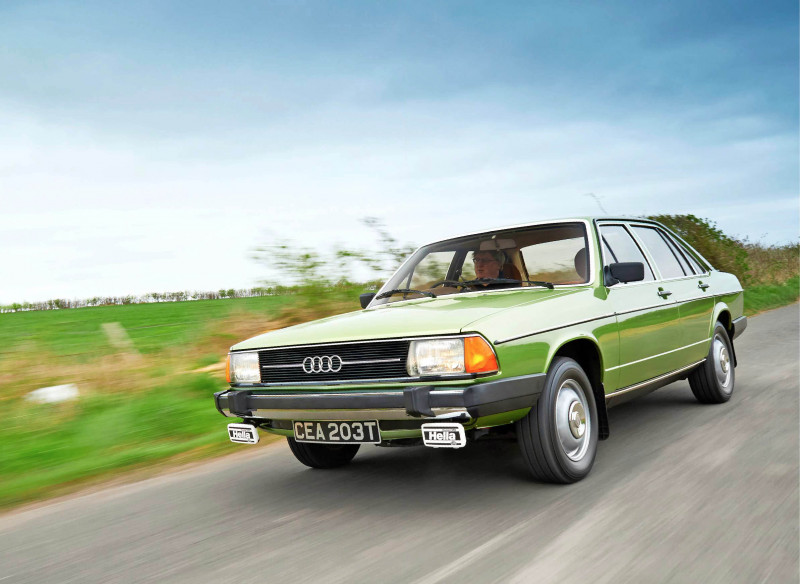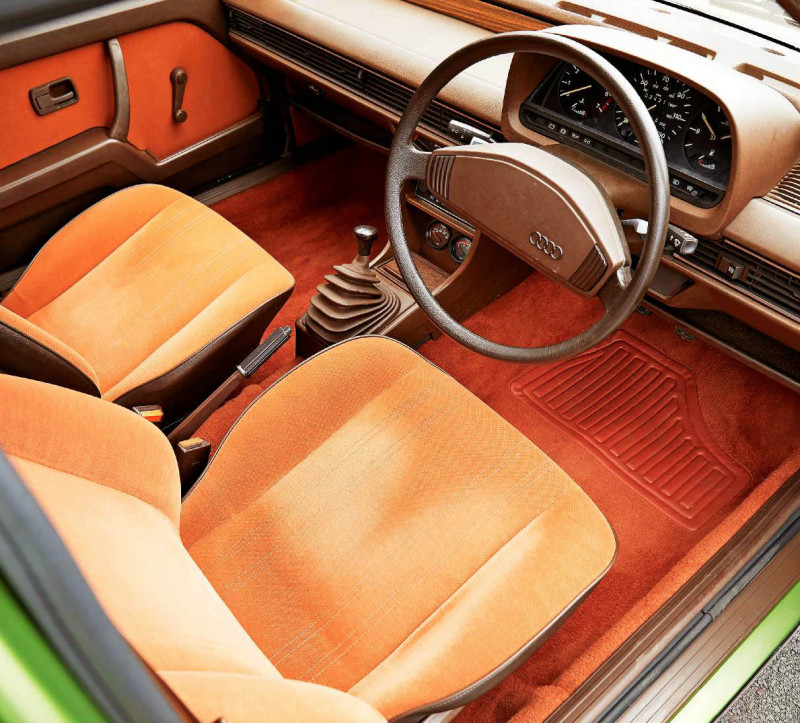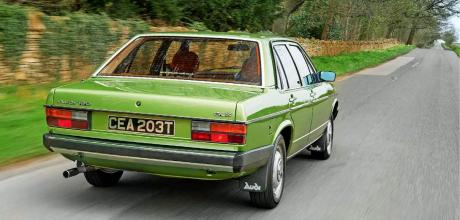1978 Audi 100 GLS C2 Typ 43
Radical, yet refined and restrained, shockingly few examples of the ground-breaking second-generation Audi 100 survive. Did it deserve a better fate?
Words JAMES WALSHE
Photography MATT HOWELL
Lord of the Four Rings Audi’s 100 once defined the marque. Why has it been forgotten?
LORD OF THE FOUR RINGS
Origin of a species: has the world unfairly forgotten the ‘B2’ Audi 100?
With an Audi occupying almost every inch of road in 2022, it’s disappointing to discover Ferdinand Piëch’s range of sophisticated Seventies saloons has all but vanished. This is especially mystifying when you consider how well Audi designed and built them. In an era when car doors clanged shut like biscuit tin lids, this rare Audi 100’s close with a pleasing thud. Step aboard a ‘C2’ 100, such as our Reseda Green GLS, shut your eyes and pat your way around the cockpit. Every aspect of the fit and finish, from the seat fabrics and soft-touch plastics, oozes quality. Right-angled cabin architecture aside, you could be sat inside any modern executive. Open your peepers again and you’re right back in the Seventies, engulfed in first-rate slabs of brown. You sit on wide, reassuringly firm seats covered in thick high-quality fabric and while the trained eye will note period VW Group switches and door handles, there’s a tasteful slice of fake wood across the top of the dash to add a little visual allure.

‘How could such a well-accomplished machine have been so painfully overlooked?’
Unlike its German rivals, Audi engineering, construction and rust-prevention has remained unequivocally consistent throughout the decades, while it sat somewhere in the middle when it came to driving dynamics. But what the 100 lacks in the way of BMW sharpness or Mercedes-Benz waft, it makes up for in surefootedness. With an engine set ahead of the driven wheels, the Audi’s road manners are impeccable from the moment you pull away from the kerb. Placed behind the large two-spoke wheel, large and pleasingly clear white-on-black VDO instruments peer back. They don’t move much on this 1984cc single-carburettor four-cylinder version, but performance is more than adequate. It’s also very refined, with no unpleasant vibrations, rattles or clunks. This is one beautifully made car.

The model line that made Audi famous has been inexplicably overlooked for more than half a century. Emerging from the drawing board offices of NSU and DKW in the wake of Sixties takeover turmoil, the elegant, high-quality first-generation Audi 100 of 1968 set the company on course to become one of the world’s most successful car makers. Thereafter, the ‘C1’ 100 was superseded by a string of technically advanced executive saloons – including our handsome second generation ‘C2’ 100.
You’d have thought a useful boost in fortune from the Quattro’s rally success would have made a significant dent in the fortunes of BMW and Mercedes-Benz, but Audi’s line-up remained wedged for decades in the shadow of those high-flying offerings from Munich and Stuttgart. Comparably, every aspect of our 1978 example is as pleasing as either, from the neat profile – the result of 260 hours in the wind tunnel – and crisp styling details with deftly placed slivers of chromework around the glass, to the flawlessly tight shut-lines and sturdy-looking fixtures. Certainly, it doesn’t take long at the wheel to realise the Audi 100 was a well-defined cut above similarly priced offerings of the day from Britain, France and Italy. In recent decades, the number of survivors has fallen sharply. So how could such a well-accomplished car have been so painfully overlooked?
Perhaps Audi itself was to blame. The advantages of buying this big executive were dispensed to the public with refreshingly wry but understated delivery. In the case of our second-generation Audi 100 of 1976, the period brochure’s marketing message was a mischievous elbow to the ribs of the conventional executive buyer – ‘The intelligent man’s guide to choosing a luxury saloon’, it purred. In a further act of brazen provocation, the pamphlet goes on to condemn our sister magazine CAR as the ‘scourge of the motoring world’ and suggests Audi engineers were sufficiently peeved by previous criticisms about interior noise, they modified the car just to ‘shut the journalists up’.
When the C2’s slippery 1982 replacement was launched, the TV campaign was similarly droll, with sardonic voiced Geoffrey Palmer delivering the ‘Vorsprung Durch Technik’ maxim. Couple this approach to a range of unusual five-cylinder motors, Audi had wilfully stuck itself into the small category of leftfield choices of the day, mostly occupied by big Saabs and Citroëns.
Audi buyers of the Seventies and Eighties might well have been noticeably free-thinking and unconventional, but the cars never sold in high volumes when compared to other European rivals. All that changed when the exquisite TT appeared in 1999, at which point Audi was propelled into the stratosphere of aspirational, must-have brands for the new millennium. This was no fluke. In its range of executives, the firm had spent decades quietly brewing its cocktail of world-beating credentials, with Ingolstadt periodically unveiling a car that broke new ground in performance, refinement and safety. All it took was the right car, in the right moment, and the TT was it. Perhaps the second-gen 100 looked too restrained but it had the kind of pedigree that makes a TT resemble a wheelbarrow. Development of the C2 had been initiated by Ferdinand Piëch – grandson of Ferdinand Porsche and Audi’s recently appointed manager of its engineering department. Fresh from his success at Le Mans with his Porsche 917 and buoyed by Audi’s accomplishments in quality, a confident Piëch quickly got to work and began to experiment. After showing off an all-wheel-drive 100 prototype – long before the Quattro appeared – Piëch’s new 100 was unveiled in the Autumn of 1976, after which he pushed ahead with development of the world’s first five-cylinder petrol engine, paying close attention to a similar diesel unit Mercedes-Benz had recently developed. As with that engine, Piëch’s also had crankshaft throws at 144-degree intervals. His obsession was for the 100 to boast superior economy and performance to all other four- and six-cylinder cars of the time.
Sadly, our four-cylinder test example is too early for all that. Piëch’s attention to detail is still evident in this 1984cc GLS, but once you’ve experienced the bigger engine, you can’t help feeling a bit short-changed when you’re being tugged along by the 115bhp VW unit – especially with a fistful of just four gears. However, the engine noise never intrudes into the cabin the way it does aboard a Ford or Vauxhall of this era.
All 100s had a slightly dead feel to the steering, that is until you throw them into a bend. Handling is predictable, if naturally nose-heavy; some satisfying enthusiastic hustling is possible out in the countryside where cornering is surprisingly flat. Although never sporty, the front-wheel-drive 100 feels sure-footed, the ride composure rarely unsettled.
Steering is by unassisted rack and pinion, well-weighted at speed but a little heavy around town. Later 100s got power steering, while almost all UK versions adopted that five-cylinder engine after 1978.
Those models are the most sought-after these days, along with the higher-spec 200 and 200 Turbo models, recognisable by their quad headlamps. Don’t get too excited, however. There are so few examples of any C2 Audi left, that current owners in the UK reveal that they all seem to know each other’s names. This gives the second-generation 100 a near mythical status in certain classic car circles, with recent sightings of a GL5S at the NEC Classic Motor Show causing a frenzy amongst this small but enthusiastic crowd. I know this because I was among them. And, just as I did so with our groovy green test car, I made a beeline for the back seat.
My father, a former design engineer, owned a 100 GL5E in the mid-Eighties, so I spent a great deal of time being ferried around in the back of that spacious and sumptuous cabin. On summer evenings, I’d be swooping through the garden in my Millennium Falcon when I’d hear the distant thrum of an approaching five-cylinder engine and shriek through the patio doors. ‘Dad’s home!’ Recently, I asked my father why he hadn’t bought one of the contemporary BMWs or Mercedes- Benzes at the time. His considered reply could have been a line from any of Audi’s period advertisements. ‘Why would I choose to drive an ordinary car?’
TECHNICAL DATA 1978 Audi 100 GLS C2 (Typ 43)
- Engine 1984cc four-cylinder, ohc, Solex 2B3 twin choke carburettor
- Power and torque 115bhp @ 5500rpm; 116lb ft @ 3500rpm
- Transmission Four-speed manual, front-wheel drive
- Steering Rack and pinion
- Suspension Front: independent, MacPherson struts, coil springs, telescopic dampers, anti-roll bar. Rear: independent, trailing arms, Panhard rod, coil springs, telescopic dampers, integral anti-roll bar
- Brakes Servo discs front, drums rear
- Weight 1150kg
- Performance 0-60mph: 10.9sec
- Top speed: 110mph
- Cost new £4850
- Classic Cars Price Guide £2750-£8000
Subtle profile helped by classy touches of stainless steel trim Audi was a champion of FWD… until the Quattro arrived
All C2s got mild facelift from 1979, as well as an extra engine cylinder. ‘Sporty’ GLS model got voltmeter and oil temperature gauge. Comfortable cabin of exceptional quality and is free of squeaks. Impressive luggage space impeded by awkwardly high sill. First C2 Audi 100s were fitted with VAG’s 1984cc four-cyl engine. Early 2.0-litre LS and GLS soon replaced by five-cyl versions.
OWNING A 100
John McLannahan and his wife Jackie have owned their 1981 example twice. ‘The first time around, Jackie bought it as her first car in 1990 when she was living in Germany. She drove it back to the UK and by the mid- Nineties, it had a few mechanical issues so we traded it in for a Peugeot 106. We hated it and always missed the Audi’s comfort!’ Almost a decade passed and one day, while out walking their dog, John and Jackie spotted their old Indiana Red 100 CS at the back of a yard. ‘We couldn’t believe it. The people who’d bought the car had stashed it away in a warehouse and hadn’t done anything with it. We bought it back for £170!’ A further surprise came when they realised Jackie was still technically still the owner, because the registration papers hadn’t been changed.
These days Secretary and Treasurer at Club Audi, John says that with just six cars known to exist in the UK, owning the C2 100 can be a major worry when it comes to finding spare parts. ‘It’s lucky the car is so well made, because it isn’t exactly demanding! I’ve replaced the valve stem seals and it’ll be getting its first replacement clutch soon, but otherwise, we’ve never had any trouble from the car.’ Reliability is a major appeal for John, as well as the driving experience. ‘I tucked the 100 away during the recent lockdown periods but on pulling off the cover eight months later, it started on the button. To hear that five-cylinder again was a delight. It has some real go, and I’m always very satisfied at how economical it is. For me, it wins on all counts.’


